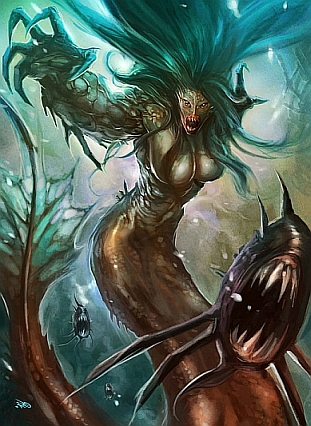Z Is for Zahia
And here I am, finishing up the A to Z blogging challenge. Huzzah! Since I’ve been doing an NPC a week, that seemed like a good way to wrap things up. The other NPCs (Gröd the Gorilla, Sultan Nagendra, and the Thriller) were all leader monsters, conquerors of sorts who seek to expand their ability to control and destroy. Zahia, however, wants to be left alone to play with her pets.
Zahia is a half-fiend mermaid, the child of an aquatic fiend and an extremely unfortunate mermaid. Under normal circumstances, the progeny of such a union would never permitted to be born, but the fiend kept its victim captive until its unholy offspring was delivered. It then fed Zahia’s mother to her as its first post-natal meal. Zahia’s father then transported her to a remote ocean chasm and abandoned her to fend for herself.

Fend she did, surviving by hunting and scavenging, roaming through the chasm alone. One fateful evening while she was stargazing among the waves, she spotted a passing ship. Curious, Zahia followed the vessel, catching her first glimpses of surface dwellers. The ship led her to a harbor and port, and the monstrous mermaid hid herself in some sea caves. Quite by accident, she was discovered by a witch, who taught Zahia to contact otherworldly powers that could teach her arcane arts. Zahia was a capable student with an affinity for wild things. When she learned all she could from the local witch, Zahia killed her and ate her, as befits a mother figure.
Zahia swam to a bigger harbor with a larger port near more extensive sea caves. She fortified her sea caves with devious traps and schools of predatory fish. She discovered the routes used by smugglers to enter the city’s substructures so that she can move about, watching what she regards as the amusing antics of the surface dwellers. Often, when a stray surface dweller catches her fancy, she takes him or her back to her watery lair. Zahia’s victims seldom live long, but that’s satisfactory for the mermaid. She enjoys playing with the drowned corpses almost as much as she enjoys her torturous games with them while they live. When the bodies are too decayed for play, Zahia eats them, sharing the remains with her fishy guards.
All of this happens without the knowledge of almost everyone in the city. It isn’t uncommon for people to disappear in a big city, especially one so near to the lures of a life at sea. A few smugglers have seen Zahia flying slowly through the tunnels beneath the city, and then cower and hide until she passes. A few drunken sailors think they may have seen a mermaid slipping through the dark harbor waters at night, but who believes the tales of besotted salt dogs?
Zahia
Female advanced half-fiend merfolk white hair witch 11
CR 15; XP 51,200
NE Medium outsider (aquatic, native)
Init +6; Senses darkvision 60 ft., low-light vision; Perception +2
DEFENSE
AC 27, touch 19, flat-footed 20 (+2 deflection, +6 Dex, +1 dodge, +8 natural)
hp 107 (11d6+66)
Fort +13, Ref +13, Will +10
DR 10/magic; Immune poison; Resist acid 10, cold 10, electricity 10, fire 10; SR 25
OFFENSE
Speed 5 ft., fly 10 ft. (good), swim 50 ft.
Melee 2 claws +11 (1d4+3), bite +11 (1d6+3), or
Melee hair +12 (1d6+7 plus grapple)
Reach (with hair) 15 ft.
Special Attacks cunning trigger, white hair
Spell-Like Abilities (CL 11th, concentration +17)
3/day- darkness, poison (Fort 20)
1/day- blasphemy (Will partial 23), contagion (Fort 19), desecrate, unholy blight (Will partial 20)
Spells Prepared (CL 11th, concentration +18)
6th- greater heroism, slay living (Fort partial 23)
5th- cure critical wounds, teleport, wreath of blades (Ref half 22)
4th- summon nature’s ally IV, spite (vampiric touch), threefold aspect
3rd- countless eyes, dispel magic, eruptive postules (Fort partial 20), ray of exhaustion (Fort partial 20), spit venom (Fort partial 20), vampiric touch (already cast)
2nd- cure moderate wounds, feast of ashes (Fort 19), glitterdust (Will 19), haunting mists (Will partial 19), pernicious poison (x2)
1st- bungle (Will 18), fumbletongue (Will 18), frostbite, infernal healing, mage armor, ray of enfeeblement
0th- detect magic, guidance, read magic, resistance
STATISTICS
Str 16, Dex 23, Con 22, Int 25, Wis 14, Cha 22
Base Atk +5; CMB +8 (+14 grapple with hair); CMD 24 (can’t be tripped)
Feats Combat Expertise (-2 attacks/+2 dodge), Combat Reflexes, Dodge, Improved Natural Attack (hair), Improved Trip, Weapon Finesse
Skills Craft (traps) +21, Fly +24, Handle Animal +17, Intimidate +20, Knowledge (arcana) +21, Knowledge (history) +21, Knowledge (nature) +21, Knowledge (the planes) +21, Spellcraft +21, Swim +22; Racial Modifiers +4 Fly, +8 Swim
Languages Aboleth, Abyssal, Aklo, Aquan, Common, Draconic, Elven, Sahuagin, Sylvan
SQ amphibious, witch’s familiar (king crab), witch’s patron (animals)
SPECIAL ABILITIES
Cunning Trigger (Ex): Zahia can use a swift action to set off any trap within 30 feet that she constructed.
White Hair (Su): Zahia has the ability to use her hair as a weapon. Whenever the hair strikes a foe, the witch can attempt to grapple that foe with her hair as a swift action without provoking an attack of opportunity. When Zahia grapples a foe in this way, she does not gain the grappled condition. The hair cannot be sundered or attacked as a separate creature. In addition, Zahia’s hair has the following abilities:
Constrict (Ex): When Zahia’s hair successfully grapples an opponent, it can begin constricting her victim as a swift action, dealing damage equal to that of its attack.
Trip (Ex): When Zahia successfully strikes a foe with her hair, she can attempt a combat maneuver check to trip the creature as a swift action.
Pull (Ex): When Zahia successfully strikes a foe with her hair, she can attempt a combat maneuver check to pull the creature 5 feet closer to her as a swift action.
Strangle (Ex): When Zahia’s hair is grappling with an opponent, that creature is considered strangled, and cannot speak or cast spells with verbal components.
GEAR
cauldron of the dead, cloak of resistance +4, ring of invisibility, ring of protection +2, staff of dread (50 charges), wand of vision of hell (50 charges), plus 92,350 gp for traps in her lair, other equipment, et cetera
Staff of Dread
Aura moderate necromancy; CL 8th
Slot none; Price 18,400 gp; Weight 5 lbs.
Description: This twisted, dark gray staff allows use of the following spells:
* cause fear (1 charge)
* qualm (1 charge)
* cackling skull (1 charge)
* fear (2 charges)
Construction Requirements: Craft Staff, cackling skull, cause fear, fear, qualm; Cost 9,200 gp




